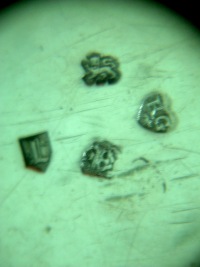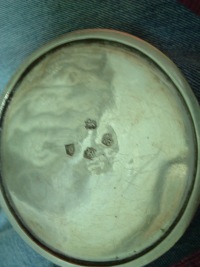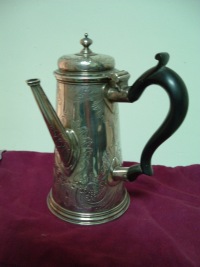by David
McKinley
(click on photos to enlarge image)
The Background To "Duty Dodgers"
Duty at the rate of 6d per Troy ounce was first laid on
English silver plate by an Act of 1719 entitled "An Act For
Laying A duty On Wrought Plate" which came into affect on
1st. June 1720.
Each silversmith had to send a list of all newly hallmarked wares to
his nearest Excise Office whose officers were then required to go to
his workshop, weigh the plate and record the appropriate duty. The
silversmith was then given up to six weeks in which to pay this duty
The important feature of this wording is that it applied to
‘hallmarked’ plate so that in order to avoid paying this tax
some silversmiths avoided having their plate hallmarked.
Some, like the famous Paul de Lamerie, just didn’t bother to
have marks of any sort applied to some of their plate and there
is even now quite a substantial amount of silver plate in
England of this period which is just unmarked.
Other silversmiths merely struck their own makers’ marks several
times in order to simulate hallmarks but there were those who
found ways to ‘hallmark’ their plate fraudulently. The commonest
way in which this fraud was perpetrated was by transposition.
Transposition is the practice of cutting out the marks from old
or small plate and soldering them into new plate and although
the penalty for this offence was a fine of £500.00 or, later,
transportation, the practice seems to have been fairly widespread.
Items of plate exhibiting this fraud are known as ‘Duty Dodgers’.
So widespread did the practice become that the Goldsmiths’
Company of London, having some responsibility for applying the
law regarding all wrought plate, decided to take steps to
overcome it and to clarify their own position with regard to it.
They elected a committee of their own members, including de
Lamerie, to draw up a Bill to lay before Parliament which would
make clear exactly what was required of their members with
regard to hallmarking and exactly what charges they could impose
for this service.
The Bill would also make clear what penalties would be imposed
for infringement and would clarify which items of plate would be
exempt. The matter of the form to be adopted for makers’ marks
would also be clarified.
So comprehensive were the results of their endeavours that they
became the ‘principal of hallmarking law in England until 1975’
(J.S.Forbes-HALLMARK- A history of the London Assay Office- p201).
The findings of this committee were put before the House of
Commons in February 1738 but did not get onto the statute book
before Parliament was prorogued. Thus, although what became ‘The
Plate Offences Act’ is dated 1738, it was not until 1739 that it
became law.
So far reaching would be the affects of this new law that the
Goldsmiths’ Company decided to mark its introduction by altering
the form of all their hallmarking punches.
This would normally have been done at the beginning of the
marking year which throughout the 18th century (and in fact
until 1975) was the 29th May or a day either side of this date.
In fact the Bill was not expected to become law until the first
week in June 1739 and the changing of the date letter in that
year was therefore postponed until 8th June.
In the event the Bill did not gain the Royal Assent until 14th
June and, being unwilling to delay further, the Company went
ahead and introduced the new date letter, the lower case letter
‘d’, on 6th June but without altering the outlines either to the
date letter punch or those of the lion and leopard. Thus the
date letter for the beginning of the 1739 marking year appears
in a Norman ‘Heater’ shield as it had done, with the exception
of ‘K’ and ‘M’ for the years 1725 and 1727 which are in square
outlines, since 1561.
It was not until 18th July that new distinctive punches were
produced with indented outlines and these outlines remained in
force until the end of the 1755 marking year (27th May 1756) so
that transposition of these marks can be easily identified if
the style of a piece of plate on which they are struck does not
fit with this date span.
The marks on the base of the coffee pot shown in the November
newsletter are a mixture of a pre 1739 date letter, with its
heater shield outline, and 1739 to 1755 lion and leopard with
their indented outlines and thus the pot is easily recognisable
as a ‘Duty Dodger’!
Apart from getting involved in legislation regarding Duty
Dodgers, The Goldsmiths’ Company also took its own practical
steps to overcome the problem and these resulted in the
introduction of mechanical marking, but that is another story.
David McKinley
- 2009 -
David McKinley devotes much of his time to researching
the history of silversmithing in England with particular
reference to hallmarking at the London office. He writes
for both The Silver Spoon Club of Great Britain and The
Silver Society.
|
|
|
 ASSOCIATION OF SMALL COLLECTORS OF ANTIQUE SILVER
ASSOCIATION OF SMALL COLLECTORS OF ANTIQUE SILVER

